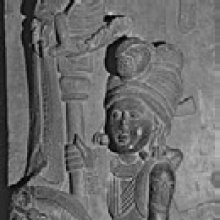Garudadhvaja, Garuḍadhvaja, Garuda-dhvaja: 12 definitions
Introduction:
Garudadhvaja means something in Hinduism, Sanskrit, Jainism, Prakrit, the history of ancient India. If you want to know the exact meaning, history, etymology or English translation of this term then check out the descriptions on this page. Add your comment or reference to a book if you want to contribute to this summary article.
Images (photo gallery)
In Hinduism
Purana and Itihasa (epic history)
Source: archive.org: Shiva Purana - English TranslationGaruḍadhvaja (गरुडध्वज) refers to the “Garuḍa-bannered deity” (i.e., Viṣṇu), according to the Śivapurāṇa 2.2.38.—Accordingly, as Brahmā narrated to Nārada:—“[...] Defeated thus by Dadhīca who was the server of Mṛtyuñjaya and who resorted to Śiva, Kṣuva went to the forest immediately and propitiated Viṣṇu, the younger brother of Indra. The lord Viṣṇu satisfied with his worship revealed himself to him in the divine form of the Garuḍa-bannered deity”.
Source: Cologne Digital Sanskrit Dictionaries: The Purana IndexGaruḍadhvaja (गरुडध्वज).—Viṣṇu (Kṛṣṇa).*
- * Matsya-purāṇa 150. 211: 152. 21: 163. 106-7. Vāyu-purāṇa 24. 90: 96. 239.

The Purana (पुराण, purāṇas) refers to Sanskrit literature preserving ancient India’s vast cultural history, including historical legends, religious ceremonies, various arts and sciences. The eighteen mahapuranas total over 400,000 shlokas (metrical couplets) and date to at least several centuries BCE.
In Jainism
General definition (in Jainism)
Source: WikiPedia: JainismGaruḍadhvaja (गरुडध्वज) is another name for the nine Vāsudevas (or Viṣṇu, Nārāyaṇa), referring to a set of nine “heroes” and counterpart of the antagonistic Prativāsudevas (or Prativiṣṇus, Pratinārāyaṇas), mentioned in both Śvetāmbara and Digambara literature.—In every half time cycle, there are 9 sets of Balabhadras (gentle heroes), Vasudevas (violent heroes) and Prativāsudevas (anti-heroes). Unlike in the Hindu Puranas, the names Balabhadra and Narayana are not restricted to Balarama and Krishna in Jain Puranas. Instead they serve as names of two distinct classes of mighty half brothers, who appear nine times in each half of the time cycles of the Jain cosmology and jointly rule half the earth as half-chakravarti. Ultimately Pratinaryana is killed by Narayana for his unrighteousness and immorality.

Jainism is an Indian religion of Dharma whose doctrine revolves around harmlessness (ahimsa) towards every living being. The two major branches (Digambara and Svetambara) of Jainism stimulate self-control (or, shramana, ‘self-reliance’) and spiritual development through a path of peace for the soul to progess to the ultimate goal.
India history and geography
Source: Cologne Digital Sanskrit Dictionaries: Indian Epigraphical GlossaryGaruḍadhvaja.—(CII 4), title of a ruler. Note: garuḍadhvaja is defined in the “Indian epigraphical glossary” as it can be found on ancient inscriptions commonly written in Sanskrit, Prakrit or Dravidian languages.

The history of India traces the identification of countries, villages, towns and other regions of India, as well as mythology, zoology, royal dynasties, rulers, tribes, local festivities and traditions and regional languages. Ancient India enjoyed religious freedom and encourages the path of Dharma, a concept common to Buddhism, Hinduism, and Jainism.
Languages of India and abroad
Sanskrit dictionary
Source: DDSA: The practical Sanskrit-English dictionaryGaruḍadhvaja (गरुडध्वज).—an epithet of Viṣṇu; समाहितमतिश्चैव तुष्टाव गरुडध्वजम् (samāhitamatiścaiva tuṣṭāva garuḍadhvajam) V. P.
Derivable forms: garuḍadhvajaḥ (गरुडध्वजः).
Garuḍadhvaja is a Sanskrit compound consisting of the terms garuḍa and dhvaja (ध्वज).
Source: Cologne Digital Sanskrit Dictionaries: Shabda-Sagara Sanskrit-English DictionaryGaruḍadhvaja (गरुडध्वज).—m.
(-jaḥ) A name of Vishnu. E. garuḍa, and dhvaja a symbol; whose symbol is Garuda.
Source: Cologne Digital Sanskrit Dictionaries: Benfey Sanskrit-English DictionaryGaruḍadhvaja (गरुडध्वज).—m. a name of Viṣṇu, Mahābhārata 2, 30. Go
Garuḍadhvaja is a Sanskrit compound consisting of the terms garuḍa and dhvaja (ध्वज).
Source: Cologne Digital Sanskrit Dictionaries: Monier-Williams Sanskrit-English Dictionary1) Garuḍadhvaja (गरुडध्वज):—[=garuḍa-dhvaja] [from garuḍa] mfn. (cf. [gana] arcādi, [Gaṇaratna-mahodadhi 185 [Scholiast or Commentator]]) having Garuḍa in its banner (Kṛṣṇa’s chariot), [Bhāgavata-purāṇa x]
2) [v.s. ...] m. = -ketu, [Mahābhārata; Bhāgavata-purāṇa; Prasannarāghava iv, 41.]
Source: Cologne Digital Sanskrit Dictionaries: Yates Sanskrit-English DictionaryGaruḍadhvaja (गरुडध्वज):—[garuḍa-dhvaja] (jaḥ) 1. m. Vishnu.
[Sanskrit to German]
Sanskrit, also spelled संस्कृतम् (saṃskṛtam), is an ancient language of India commonly seen as the grandmother of the Indo-European language family (even English!). Closely allied with Prakrit and Pali, Sanskrit is more exhaustive in both grammar and terms and has the most extensive collection of literature in the world, greatly surpassing its sister-languages Greek and Latin.
Kannada-English dictionary
Source: Alar: Kannada-English corpusGaruḍadhvaja (ಗರುಡಧ್ವಜ):—
1) [noun] a banner with the figure of Brahminee kite (Garuḍa).
2) [noun] Viṣṇu, who has Garuḍa’s figure in his banner.
Kannada is a Dravidian language (as opposed to the Indo-European language family) mainly spoken in the southwestern region of India.
See also (Relevant definitions)
Partial matches: Dhvaja, Garuda.
Full-text: Heliodorus, Garudanka, Garudapali, Nandidhvaja, Antialkidas, Garuda, Barbarika, Barbari, Kirati, Triprishtha.
Relevant text
Search found 14 books and stories containing Garudadhvaja, Garuḍadhvaja, Garuda-dhvaja, Garuḍa-dhvaja; (plurals include: Garudadhvajas, Garuḍadhvajas, dhvajas). You can also click to the full overview containing English textual excerpts. Below are direct links for the most relevant articles:
Garga Samhita (English) (by Danavir Goswami)
Verse 2.25.21 < [Chapter 25 - The Rāsa-dance Pastime]
Manusmriti with the Commentary of Medhatithi (by Ganganatha Jha)
Verse 9.285 < [Section XXXVIII - Treatment of Criminals and their Punishment]
Harivamsha Purana (by Manmatha Nath Dutt)
Chapter 104 - Krishna’s Children < [Book 2 - Vishnu Parva]
Chapter 114 - Krishna Rescues the Brahmana’s Sons < [Book 2 - Vishnu Parva]
Chapter 122 - Anxiety of the Yadavas for Aniruddha < [Book 2 - Vishnu Parva]
The Matsya Purana (critical study) (by Kushal Kalita)
Part 1.1 - Different names of Viṣṇu < [Chapter 4 - Religious aspects of the Matsyapurāṇa]
Amarakoshodghatana of Kshirasvamin (study) (by A. Yamuna Devi)
Gods and Divinities < [Chapter 4 - Cultural Aspects]
Lord Hayagriva in Sanskrit Literature (by Anindita Adhikari)

